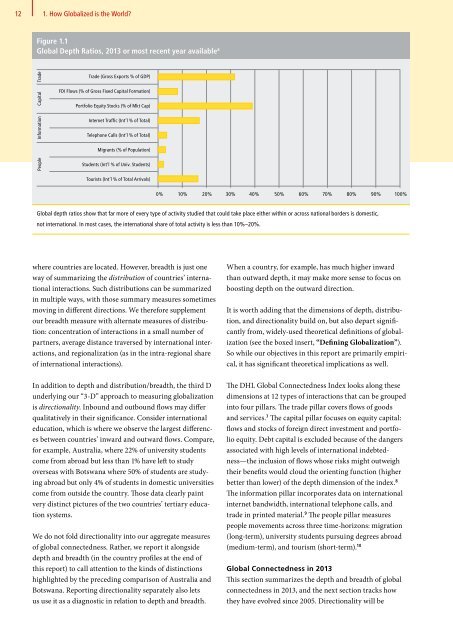DHL Global Connectedness Index 2014
DHL Global Connectedness Index 2014
DHL Global Connectedness Index 2014
- No tags were found...
Create successful ePaper yourself
Turn your PDF publications into a flip-book with our unique Google optimized e-Paper software.
12 1. How <strong>Global</strong>ized is the World<br />
Figure 1.1<br />
<strong>Global</strong> Depth Ratios, 2013 or most recent year available 6<br />
Trade<br />
Capital<br />
Information<br />
Trade (Gross Exports % of GDP)<br />
FDI Flows (% of Gross Fixed Capital Formation)<br />
Portfolio Equity Stocks (% of Mkt Cap)<br />
Internet Traffic (Int’l % of Total)<br />
Telephone Calls (Int’l % of Total)<br />
Migrants (% of Population)<br />
People<br />
Students (Int’l % of Univ. Students)<br />
Tourists (Int’l % of Total Arrivals)<br />
0% 10% 20% 30% 40% 50% 60% 70% 80% 90%100%<br />
<strong>Global</strong> depth ratios show that far more of every type of activity studied that could take place either within or across national borders is domestic,<br />
not international. In most cases, the international share of total activity is less than 10%–20%.<br />
where countries are located. However, breadth is just one<br />
way of summarizing the distribution of countries’ international<br />
interactions. Such distributions can be summarized<br />
in multiple ways, with those summary measures sometimes<br />
moving in different directions. We therefore supplement<br />
our breadth measure with alternate measures of distribution:<br />
concentration of interactions in a small number of<br />
partners, average distance traversed by international interactions,<br />
and regionalization (as in the intra-regional share<br />
of international interactions). 6<br />
In addition to depth and distribution/breadth, the third D<br />
underlying our “3-D” approach to measuring globalization<br />
is directionality. Inbound and outbound flows may differ<br />
qualitatively in their significance. Consider international<br />
education, which is where we observe the largest differences<br />
between countries’ inward and outward flows. Compare,<br />
for example, Australia, where 22% of university students<br />
come from abroad but less than 1% have left to study<br />
overseas with Botswana where 50% of students are studying<br />
abroad but only 4% of students in domestic universities<br />
come from outside the country. Those data clearly paint<br />
very distinct pictures of the two countries’ tertiary education<br />
systems.<br />
We do not fold directionality into our aggregate measures<br />
of global connectedness. Rather, we report it alongside<br />
depth and breadth (in the country profiles at the end of<br />
this report) to call attention to the kinds of distinctions<br />
highlighted by the preceding comparison of Australia and<br />
Botswana. Reporting directionality separately also lets<br />
us use it as a diagnostic in relation to depth and breadth.<br />
When a country, for example, has much higher inward<br />
than outward depth, it may make more sense to focus on<br />
boosting depth on the outward direction.<br />
It is worth adding that the dimensions of depth, distribution,<br />
and directionality build on, but also depart significantly<br />
from, widely-used theoretical definitions of globalization<br />
(see the boxed insert, “Defining <strong>Global</strong>ization”).<br />
So while our objectives in this report are primarily empirical,<br />
it has significant theoretical implications as well.<br />
The <strong>DHL</strong> <strong>Global</strong> <strong>Connectedness</strong> <strong>Index</strong> looks along these<br />
dimensions at 12 types of interactions that can be grouped<br />
into four pillars. The trade pillar covers flows of goods<br />
and services. 7 The capital pillar focuses on equity capital:<br />
flows and stocks of foreign direct investment and portfolio<br />
equity. Debt capital is excluded because of the dangers<br />
associated with high levels of international indebtedness—the<br />
inclusion of flows whose risks might outweigh<br />
their benefits would cloud the orienting function (higher<br />
better than lower) of the depth dimension of the index. 8<br />
The information pillar incorporates data on international<br />
internet bandwidth, international telephone calls, and<br />
trade in printed material. 9 The people pillar measures<br />
people movements across three time-horizons: migration<br />
(long-term), university students pursuing degrees abroad<br />
(medium-term), and tourism (short-term). 10<br />
<strong>Global</strong> <strong>Connectedness</strong> in 2013<br />
This section summarizes the depth and breadth of global<br />
connectedness in 2013, and the next section tracks how<br />
they have evolved since 2005. Directionality will be





